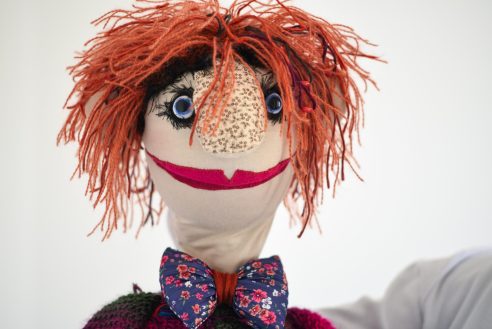
May 18 2021 Puppet It Up
Ages:
3-8Save those holey old socks—they’re great for making simple puppets; old gloves and mittens will also work. It doesn’t matter whether the eyes are symmetrical or the nose is missing. You can make the puppets ahead of time or make them with your grandchild. Decorate them with markers or fabric paint. Glue on buttons, sequins, or googly eyes.
Use the puppets to act out characters from your grandchild’s favorite books, TV shows, or movies. Make your puppets into biblical characters or Jewish holiday characters—Moses and Miriam; Esther and Haman, Judah Maccabee. Or let your grandchild make up their own characters.
![]() Educators, click HERE for a guide to using this experience in intergenerational programs.
Educators, click HERE for a guide to using this experience in intergenerational programs.
Puppet Play
The following activities — courtesy of Hedda Sharapan and The Fred Rogers Center for Early Learning and Children’s Media — can help with puppet play and demonstrate the power of puppets.
Introducing puppets
- Talk to the puppet. Start by talking to the puppet, telling it about something that happened that day.
- Talk for the puppet. Ask the puppet a question, then talk for the puppet answering you. Create a conversation between yourself and the puppet.
- Talk with the children. When you feel the children are ready, turn the puppet to the children and have it talk with them.
It’s a good idea to model these steps before offering children puppets for them to use themselves.
Using puppets for social stories
Some teachers use a puppet when they want to talk with children about behavior situations, about empathy, or making better choices. For example, you could have a puppet on your hand tell you, “I’m mad today.” You could ask why and have the puppet answer something like, “Because somebody knocked down my blocks,” or “I wanted to be first in line.” You could then ask the children to talk with the puppet and offer some suggestions or encouragement. It may be especially helpful for children who have trouble with those kinds of social or emotional situations if you remind them later on what they told the puppet.
Making puppets
The things children value the most are the things they make themselves, and puppets can be easy to make out of things like paper bags, paper plates on sticks, or socks. When children make their own puppets, they’re more likely to use them creatively in their pretend play.
You could also have children make puppets that express emotions. Have them look in a mirror, show an emotion (angry, sad, scared), and then represent it on the puppet’s face. What do the eyes look like? The mouth? When children talk through the safe distance of their own puppets, they may be better able to find ways to manage their own feelings and develop empathy.

Hedda Sharapan began working with Fred Rogers fifty-five years ago, on the very first day of taping Mister Rogers’ Neighborhood in October 1966. Currently she is a script consultant for Fred Rogers Productions’ highly acclaimed PBS children’s series Daniel Tiger’s Neighborhood. As a senior fellow at the Fred Rogers Center at Saint Vincent College in Pennsylvania, Hedda writes a monthly newsletter and has spoken all over the country, helping teachers and others reflect on Fred Rogers’ timeless messages for children and adults. Hedda is a long-distance and loving grandmother to four delightful grandchildren.




 We use technologies like cookies to remember your preferences. Consenting to these technologies will provide you with a better browsing experience. JGN never shares information about your use of our website.
We use technologies like cookies to remember your preferences. Consenting to these technologies will provide you with a better browsing experience. JGN never shares information about your use of our website.